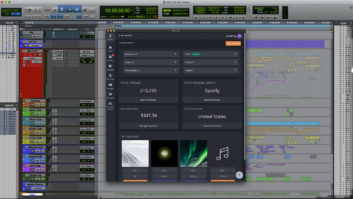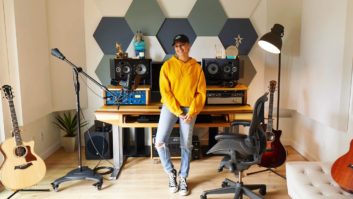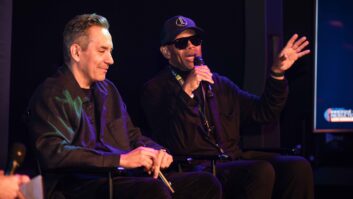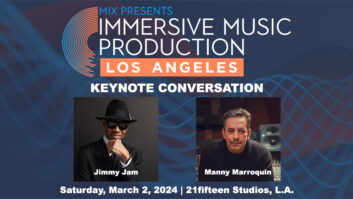Bringing Out the Funk In Utah
Veteran composer and songwriter Jim Funk was considering a number of mixing console options for Studio A at his newly built Funk Studios in Utah when he started talking with Phill Scholes, Solid State Logic’s Los Angeles-based vice president of technical operations. “After a few conversations I was a lot more educated on SSL, their preamps and what the Duality could offer,” says Funk, who unveiled his flagship control room with a Solid State Logic Duality δelta Pro-Station SuperAnalogue console as its centerpiece.

Initially conceived as a two-room facility, it has since expanded to three. Funk engaged Jerry Steckling of JSX Audio to design the complex, which features a 1300-square-foot Studio A tracking space, dubbed The Stage, offering 23-foot ceilings, custom variable acoustics and four iso booths, one housing a Yamaha C7 grand piano with Disklavier.
Funk and his staff were already predisposed toward SSL consoles, having installed an XL Desk in Studio B a year before the Duality arrived. “I think a big part of the decision to go with the Duality was the experience I was having on the XL Desk for the first year that I was working for the company,” says recording engineer Stoker White, who works for Funk’s long-established musical theater production track recording business.
“I was using a variety of outboard mic pres but always returning and summing through the XL Desk,” White recalls. “As far as using it as returns while I was tracking, I loved the easy availability of the bus compressor. When we started looking at SSL consoles for Studio A, having used the XL Desk for a year, I felt really comfortable with the sound I’d been getting.”
Freelance recording and mixing engineer Michael Greene primarily works out of Studio C, which accommodates immersive IMAX 12.0 and Dolby Atmos 7.1.4 mixing projects as well as overdubbing, using its associated iso booth, equipped with a Yamaha grand piano, or tielines from The Stage. Greene’s large-scale tracking projects in Studio A have included jazz records as well as film and video game scores.
“I’ve done a couple of jazz records that were tracked live off the floor where I’ve done a live mix back into Pro Tools. Most of the time that’s the mix that gets released. Part of that is budget, but part of it is because it just sounds great,” he says. “The overall sonics really work for me. The console sounds super warm and clear. It has a lot of warmth and bigness, but it still has a lot of clarity, without being harsh.”
Both engineers also enjoy working with the Pro-Station, a version of Duality that offers an alternate center section lay-out, wrapping the two bays of 24-channels around the operator. “The HUI integration in the Duality is spectacular,” says Greene. “I don’t even realize or ever feel like I’m using HUI protocol, which I couldn’t say when I have used it with other control surfaces. It’s really bulletproof and integrated in a way that’s really stable and effective.”
Have Monitors, Will Travel
Since her 2008 debut album Tea Bye Sea, Becca Stevens has proven herself that rare singer-songwriter who captivates the most casual of listeners but who is also as serious a musician’s musician as they come. Her new studio album WONDERBLOOM draws on funk, folk, jazz, and even metal, all while maintaining a sound that’s ineffably her. Stevens and producer Nic Hard insisted upon tracking and mixing on active studio monitors from ADAM Audio, including a pair of the three-way S3Hs, a pair of S2Vs and the ultra-compact T5Vs that go wherever Hard goes.

“Nic was always ADAM-ant about bringing the ADAM monitors to wherever we were working,” laughs Stevens, “from literal spare-bedroom studios to full facilities like Electrik Indigo Sound, Jessie Fischer’s studio across from Bi Orange where we did the majority of the tracking. We also used the smallerT5Vs when working on the go. With other speakers, there’s always been something sort of inconsistent. With ADAM monitors, we have a reference we can both depend on.”
“I’ve used ADAMs at least 12 or 13 years, beginning with the original S3As,” adds Hard. “Becca has the ears of a bat. She can hear if a vocal was edited—from the other room! Speakers that are too bright or too boomy would drive her nuts.”
Stevens and Hard also discovered that a smaller speaker doesn’t mean lesser performance. “Nic and I were also working on another record with a great Middle Eastern group called The Secret Trio,” explains Stevens. “They were across the hall at Big Orange Sheep, and I figured, heck, we’ll use the S2Vs. These are much smaller than the S3Hs, but for tracking and mixing that project, they didn’t leave us wanting for anything.”
Hand adds, “Right now I’m in New Zealand during this pandemic. The little T5Vs are all I brought with me as anything else would have incurred expensive baggage fees. They are absolutely perfect for all the work I need to do while I’m here.”







